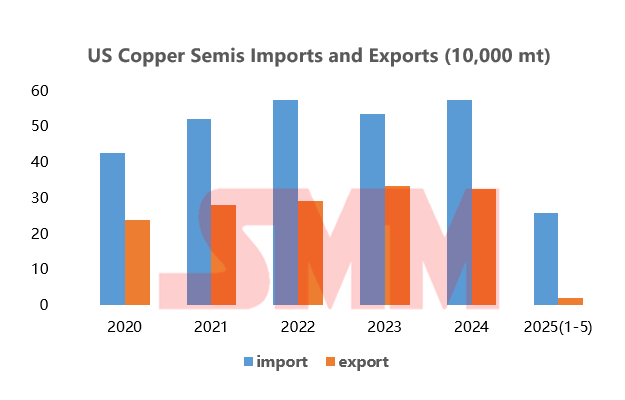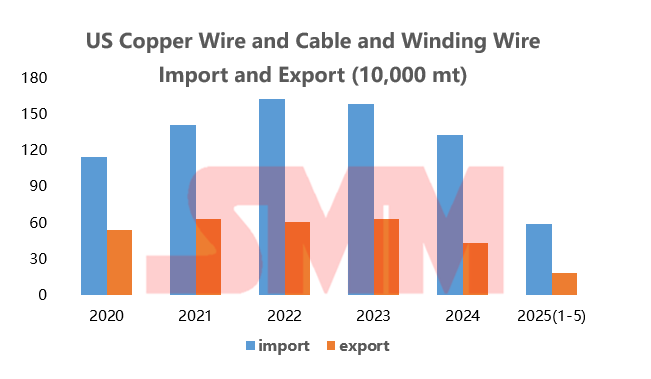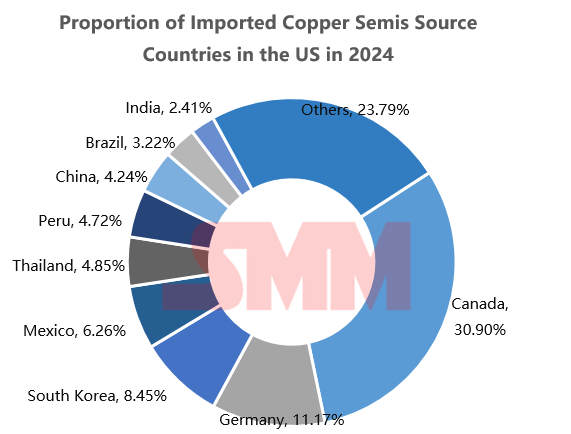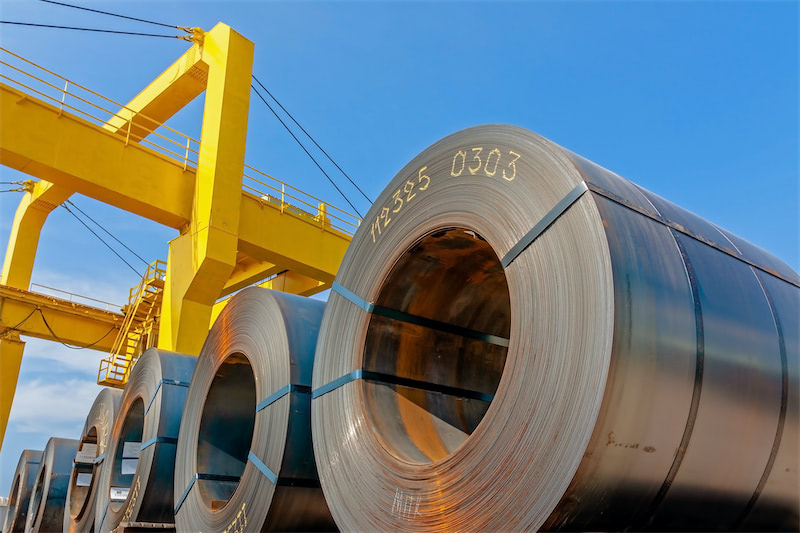






On July 30th, US time, US President Trump signed a proclamation to impose a unified 50% tariff on imported semi-finished copper products and copper-rich derivatives starting from August 1st. The tariff covers semi-finished copper products such as copper pipes & tubes, copper wires, copper billets, copper plates, etc., as well as copper-rich derivatives such as pipe fittings, cables, connectors, electrical components, etc. This news has triggered a strong market reaction. To explore the impact of this tariff policy on the copper industry, we can first look at the import and export situation of copper processed materials in the US.
Through US customs data, we filtered and analyzed the relevant import and export data of primary copper semis (HS code: 7407-7412) and copper wire and cable and copper winding wire (HS code: 854411;854419;854420;854430;854441;854449).


Data shows that in 2024, the total imports of copper semis, copper wire and cable, and winding wire in the US reached 1.9047 million mt, while the total exports were 754,200 mt. Among them, the imports and exports of copper wire and cable and winding wire stood out particularly, with imports reaching 1.33 million mt and exports 428,000 mt, making them the core categories of US copper product imports. The rising tariff costs will directly drive up the import prices of copper semis, copper wire and cable, winding wire, and other related products listed in the tariff hike catalog in the US, leading to a significant decline in the total global copper semis flowing into the US. This trend has already been evident in the decline in US copper semis imports and exports from January to May this year, and the move to impose additional tariffs on semi-finished copper products is expected to further have a structural impact on the US copper semis import and export landscape.


Now, let's examine the direct import sources of copper semis, copper wire and cable, and winding wire in the US. Canada and Mexico are the largest importers of copper semis, copper wire and cable, and winding wire for the US, accounting for 30.9% and 63.77% respectively, while China's share in these two imports is only 4.24% and 3.1%. From the data, it is evident that Canada and Mexico will bear the direct brunt of the tariff policy implementation. This is likely to significantly reduce the export profits of copper semis enterprises in Canada and Mexico, forcing some enterprises to adjust their export strategies to the US, such as reducing exports and increasing prices to transfer costs. However, it is worth noting that the existence of the United States-Mexico-Canada Agreement (USMCA) may provide a theoretical buffer against these tariffs. The agreement stipulates that products meeting origin rules can enjoy zero-tariff treatment in trade among the three countries. Theoretically, if copper semi-finished products and derivatives exported from Canada and Mexico to the US can prove to meet origin requirements, the 50% tariff imposed by the US this time should not apply, which could offset the tariff impact to a certain extent. However, given the targeted nature of the US tariff policy, the ambiguity in its implementation, and the limitations of the agreement itself in addressing complex industrial issues, the copper industries of Canada and Mexico are still likely to face a certain impact from this tariff storm. For China, given its relatively low share in US imports of copper semis and copper wire and cable, the direct impact in the short term is relatively limited. However, this move by the US may disrupt the global copper industry chain and price system, with some exports from Mexico and Canada potentially being diverted to Southeast Asia, which may impact the exports of Chinese copper processing enterprises in the future and consequently affect demand.
The US's imposition of hefty tariffs on semi-finished copper products this time is clearly aimed at supporting domestic manufacturing and investment and expansion in downstream processing sectors. However, SMM believes that the US is currently in a critical stage of energy transition and electrification upgrades, and its copper semis capacity will still struggle to meet its own demand in the short term. Under the tariff policy, processing fees for domestically processed materials such as copper rod and copper pipe & tube in the US have been rapidly pushed up. With the US's continued investment in wind and solar power, artificial intelligence, the rapid development of the automotive industry, and increased infrastructure investment brought about by the return of manufacturing, the US's demand for copper semis is expected to continue growing in the future. However, Trump's policy of imposing high tariffs on imported copper semis will undoubtedly further drive up production costs for US manufacturing, exacerbating the already tight supply and demand situation for copper semis. In the future, it will be necessary to continuously monitor the subsequent direction of US policies and changes in the global copper market landscape.
For queries, please contact Lemon Zhao at lemonzhao@smm.cn
For more information on how to access our research reports, please email service.en@smm.cn

